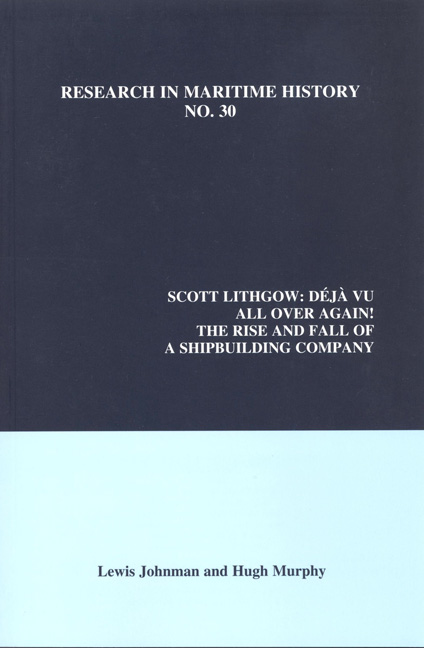Book contents
- Frontmatter
- Contents
- Acknowledgement
- Introduction
- Chapter 1 Scotts of Greenock, 1711-1945
- Chapter 2 Russell and Company to Lithgows Limited, 1874-1945
- Chapter 3 Scotts Shipbuilding and Engineering, 1945-1965
- Chapter 4 Lithgows Limited, 1945-1965
- Chapter 5 The Long March to Merger, 1965-1970
- Chapter 6 The Road to Nationalisation, 1970-1977
- Chapter 7 Nationalisation to Privatisation, 1977-1984
- Chapter 8 Déjà vu All over Again: Trafalgar House, 1984-1988
- Chapter 9 Conclusion
- Appendix
- Bibliography
Chapter 5 - The Long March to Merger, 1965-1970
- Frontmatter
- Contents
- Acknowledgement
- Introduction
- Chapter 1 Scotts of Greenock, 1711-1945
- Chapter 2 Russell and Company to Lithgows Limited, 1874-1945
- Chapter 3 Scotts Shipbuilding and Engineering, 1945-1965
- Chapter 4 Lithgows Limited, 1945-1965
- Chapter 5 The Long March to Merger, 1965-1970
- Chapter 6 The Road to Nationalisation, 1970-1977
- Chapter 7 Nationalisation to Privatisation, 1977-1984
- Chapter 8 Déjà vu All over Again: Trafalgar House, 1984-1988
- Chapter 9 Conclusion
- Appendix
- Bibliography
Summary
From February 1965 the Shipbuilding Inquiry Committee (SIC) began deliberations on how to re-invigorate the British shipbuilding industry to allow it to compete internationally. Oral and written evidence was taken from the Shipbuilding Conference and the Shipbuilding Employers Federation (SEF); the Chamber of Shipping; the Dry Dock Owners and Repairers Central Council; the National Association of Marine Engineers; and the Confederation of Shipbuilding and Engineering Unions (CSEU). In addition to the SIC's sponsoring department, the Board of Trade, which also provided its secretary, Victor Chapman, other departments, particularly the Admiralty's successor, the Ministry of Defence; Navy Department, MoD (N); and die Ministry of Labour were also consulted, as were a wide range of individual experts and subcontracting firms. Through a series of visits to shipyard and engineering establishments throughout the UK and abroad, the SIC and the Secretary of State (Shipping) at the Board of Trade, Roy Mason, attempted to gauge both the condition and prospects of the industry.
During three days in April 1965 the SIC visited all the larger shipyards and marine engineering establishments on Clydeside, with the exception of the Swan Hunter-owned Barclay Curie. Individual members were given specific briefs, but Reay Geddes had already decided in advance to visit Scotts. This was in all probability due to Michael Scott's position as chairman of the Warship Group and president-elect of the Shipbuilding Conference. When Geddes visited Greenock, he noted that Scotts’ investment in plant and equipment was “not so much a programme as a continuous process with humps.“ Although £2,250,000 had been spent since 1945, Scotts’ secretary and director, John Lee, advised him that investment decisions had not been made on the basis of calculations of the return on capital employed but as a result of the need to survive. Nor was the return on investment in individual equipment calculated. Moreover, Scotts’ methods of production tended to minimise changes in the tempo between civil and naval work. Welders, for example, were on time rates for naval work and lieu rates for civil work, where different standards of inspection applied. Due possibly to this accent on close supervision, Scotts found that it could compete with Swan Hunter and Harland and Wolff on vessels of 20,000 tons or with small builders because of its modern methods of production. Although Scotts could build vessels of up to 50,000 gross tons, the firm preferred to build two 25,000-ton vessels.
- Type
- Chapter
- Information
- Scott LithgowDéjà Vu all over again! The Rise and Fall of a Shipbuilding Company, pp. 157 - 206Publisher: Liverpool University PressPrint publication year: 2005

